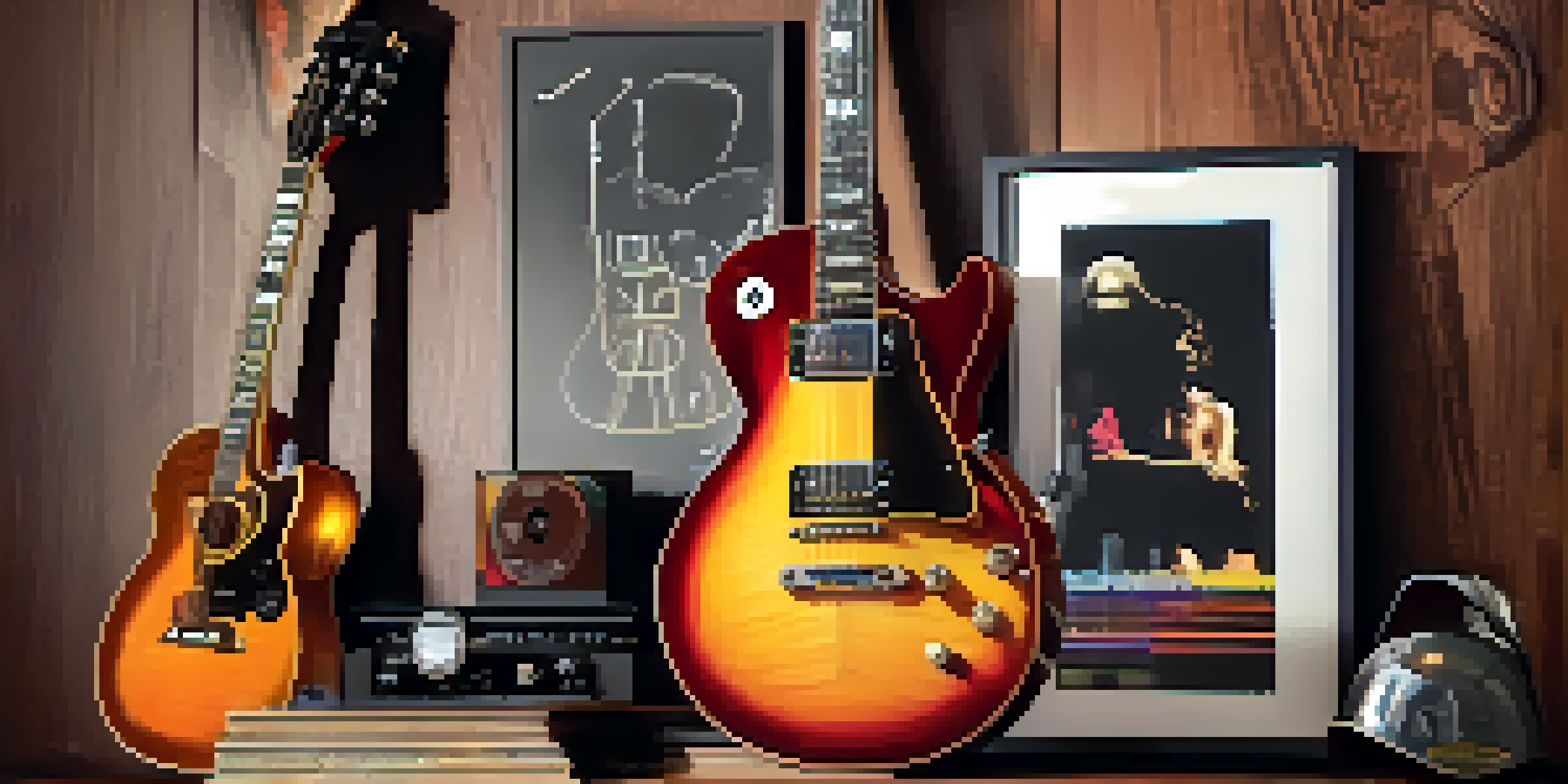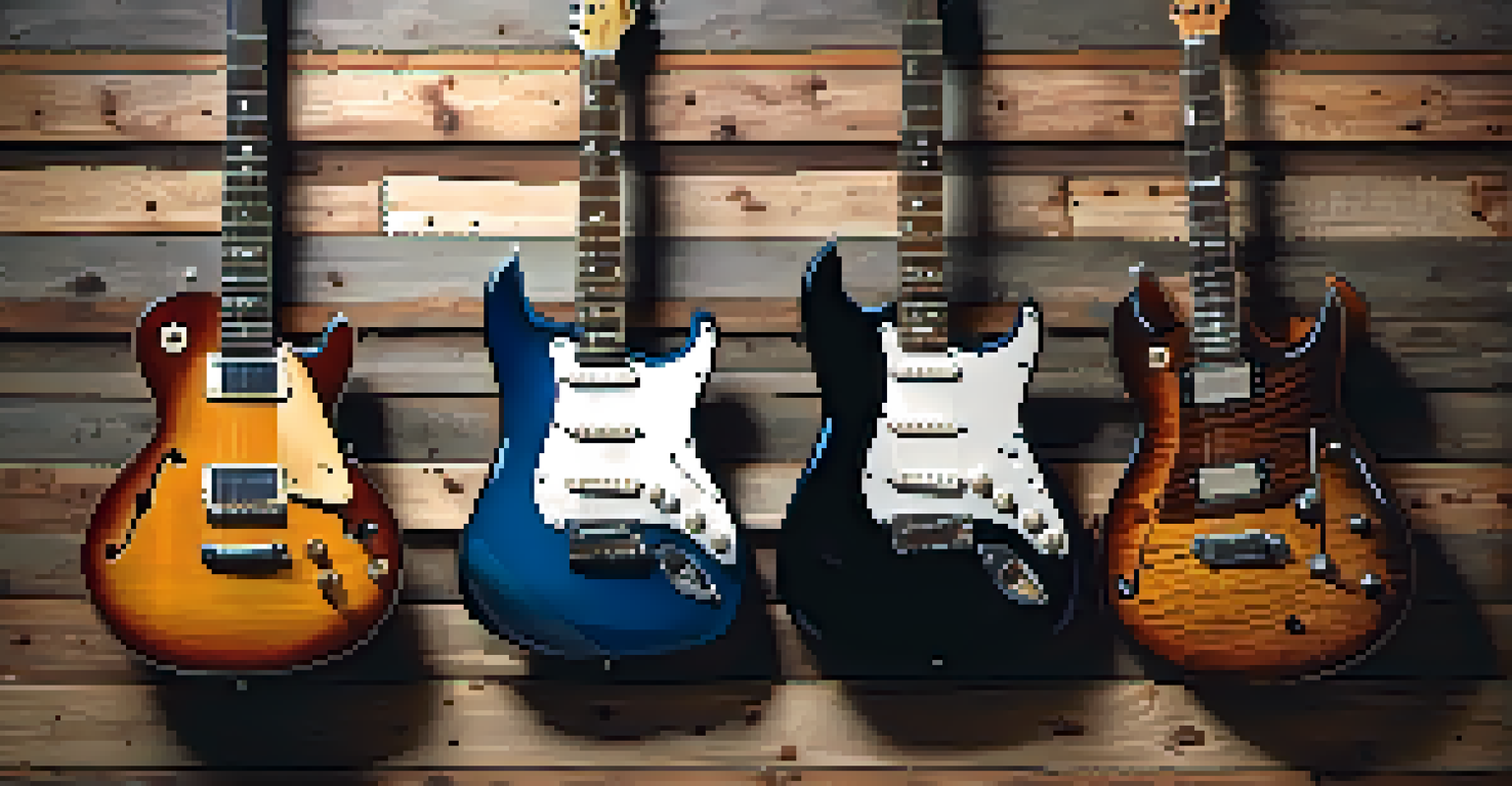Electric Guitars: Versatility and Sound Profile Overview

Understanding Electric Guitar Basics for Beginners
Electric guitars are versatile instruments that have transformed modern music. Unlike acoustic guitars, they use electronic pickups to convert string vibrations into sound, allowing for a wide range of tones. This feature not only makes them popular among rock and blues genres but also across pop, jazz, and even classical music. Understanding the basics is crucial for any aspiring guitarist.
The guitar is a miniature orchestra in itself.
At the core of an electric guitar’s sound is its body type, which can be solid, semi-hollow, or hollow. Each type offers distinct tonal qualities; for instance, solid bodies are known for their sustain and clarity, while hollow bodies provide a warmer, richer sound. This foundational knowledge helps musicians choose the right guitar based on their musical style and preferences.
Moreover, the choice of pickups—single-coil or humbucker—greatly influences the guitar's sound profile. Single-coils deliver bright and sharp tones, perfect for genres like country and surf music, while humbuckers offer a fuller, warmer sound, favored in rock and metal. By exploring these basics, guitarists can better appreciate their instrument’s versatility.
The Role of Pickups in Shaping Electric Guitar Sound
Pickups are the heart of an electric guitar's sound, acting as microphones that capture string vibrations. Single-coil pickups, known for their clarity and brightness, can produce a sharp, twangy sound that’s great for genres like blues and country. In contrast, humbucker pickups consist of two coils that work together to cancel out noise, resulting in a thicker, warmer tone favored in rock and heavier styles.

The placement of pickups on the guitar also matters, as it affects the tonal range. For instance, pickups closer to the neck deliver a mellower sound, while those positioned near the bridge provide a brighter, more cutting tone. This allows guitarists to experiment with different sounds simply by switching pickup selections, making electric guitars incredibly versatile.
Understand Electric Guitar Basics
Learning the fundamentals of electric guitars, including body types and pickups, is essential for any aspiring guitarist.
Understanding how pickups influence sound can enhance a guitarist's playing experience. By mastering techniques like adjusting pickup height or using various effects pedals, musicians can unlock a world of tonal possibilities. This exploration often leads to unique sound profiles that define an artist's signature style.
Body Types: How They Influence Tone and Playability
The body type of an electric guitar significantly impacts its overall tone and playability. Solid body guitars, like the Fender Stratocaster, are known for their sustain and resistance to feedback, making them ideal for high-volume settings. On the other hand, semi-hollow and hollow body guitars, such as the Gibson ES-335, offer a warmer, more resonant sound suitable for jazz and blues genres.
Music is the shorthand of emotion.
Moreover, the weight and size of the body can affect comfort during play. Heavier guitars can create fatigue during long sessions, while lighter models may allow for more freedom of movement. It’s essential for guitarists to consider their physical comfort as well as the tonal qualities that different body types provide.
Ultimately, selecting a guitar body type is a personal journey. Musicians often try various models to find the perfect balance between tone and playability that suits their style. This decision can be transformative, influencing their overall performance and enjoyment of playing.
The Impact of Tonewoods on Electric Guitar Sound
Tonewoods play a crucial role in shaping the sound of electric guitars, affecting everything from resonance to sustain. Common woods include mahogany, known for its warm tones and great sustain, and alder, which offers a bright and balanced sound. The choice of tonewood can enhance specific frequencies, tailoring the guitar's character to match the musician’s preferences.
Beyond sound, tonewoods also influence the aesthetics of the guitar. Unique grain patterns and colors can make each instrument visually stunning, allowing musicians to express their personality through their choice of guitar. This visual appeal often goes hand-in-hand with the tonal qualities, creating a holistic experience for players.
Pickups Shape Your Guitar Sound
The choice and placement of pickups significantly influence the tonal range and sound profile of an electric guitar.
As guitarists become more experienced, they often experiment with different tonewoods to discover what resonates with them. Understanding how various woods affect sound can lead to a more informed purchase and a deeper connection with the instrument. The right tonewood can make all the difference in achieving that perfect sound.
Exploring Different Playing Techniques on Electric Guitars
Electric guitars offer a wide array of playing techniques that can significantly alter sound and style. Techniques such as bending, tapping, and harmonics allow musicians to express themselves creatively, adding depth and emotion to their playing. For instance, string bending can create a soulful sound reminiscent of blues or rock, while tapping can produce rapid, intricate melodies.
Additionally, the use of effects pedals expands the sonic palette, enabling guitarists to explore everything from distortion to delay. By combining different techniques with various effects, players can create unique soundscapes that enhance their music. This versatility is one of the reasons electric guitars are so popular among diverse genres.
As guitarists hone their skills, they often develop a signature style that incorporates various techniques. Embracing experimentation is key—trying out new approaches can lead to unexpected discoveries and a deeper appreciation for the instrument. Whether it’s mastering a classic technique or inventing a new sound, the journey of exploration is endless.
Iconic Electric Guitars and Their Signature Sounds
Throughout music history, certain electric guitars have become iconic, each with its unique sound profile. The Fender Stratocaster, known for its bright and cutting tone, has been used by legendary artists like Jimi Hendrix and Eric Clapton. Its versatility makes it a favorite across various genres, from rock to pop.
On the other hand, the Gibson Les Paul is celebrated for its thick, warm tones and sustain, making it a staple in rock and metal. Artists like Slash and Jimmy Page have wielded this guitar to create unforgettable riffs and solos. These signature sounds often define not just songs, but entire genres.
Choosing the Right Guitar Matters
Selecting an electric guitar that matches your musical style and feels comfortable is crucial for enhancing your playing experience.
Understanding the characteristics of these iconic guitars can inspire musicians in their own playing. By exploring the sounds that have shaped music history, guitarists can gain insights into their own style and preferences. Whether it's a classic Fender or a vintage Gibson, each guitar offers a rich legacy to discover.
Choosing the Right Electric Guitar for Your Style
Selecting the right electric guitar can feel overwhelming, given the vast array of options available. Start by identifying your musical style—whether you’re into rock, jazz, or blues—as this can guide your choice. For example, a solid body guitar may suit rock players, while jazz musicians might prefer a semi-hollow body for its warmth.
Additionally, consider factors such as body shape, weight, and neck profile. Trying out different models in a local music store can help you find the perfect fit. It’s essential to choose a guitar that feels comfortable and inspiring to play, as this will encourage you to practice and improve.

Lastly, don’t forget about budget. While high-end guitars can be tempting, there are many affordable options that still deliver excellent sound and playability. The right electric guitar for you is one that matches your style, feels comfortable, and fits your budget—so take your time in making this important decision.